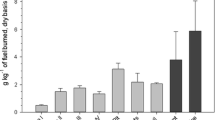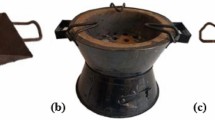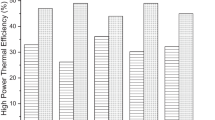Abstract
The use of charcoal is associated with indoor air pollution where users are continually exposed to combustion pollutants with detrimental effects to their health. This study analyzed the emission profiles of selected domestically used charcoal produced by different pyrolysis methods. Charcoal samples from three tree species Acacia polyacantha, Acacia xanthophloea and Eucalyptus grandis, produced by both efficient and traditional pyrolysis were collected from charcoal producers in rural Kenya. The volatile organic compounds were collected using a fabricated chimney placed on clay cook stove such that smoke was vented to a glass cannula and condensed. Extracted volatiles were analyzed by gas chromatography-linked mass spectrometry. Twenty-two polycyclic aromatic hydrocarbons were identified together with other hydrocarbons. Polycyclic aromatic hydrocarbons found in the smoke extracts with known health effects included naphthalene, 1-methylnaphthalene, 2-methylnaphthalene, fluorene, phenanthrene, anthracene, 1-methylphenanthrene, fluoranthene, benzo(a)anthracene and chrysene. There were significant differences in the concentrations of fluorine, naphthalene and pyrene emitted from Acacia polyacantha and Acacia xanthophloea prepared by traditional pyrolysis. From Acacia polyacantha, concentrations were naphthalene (110 µg/g), fluorine (72 µg/g) and pyrene (60 µg/g), while from Acacia xanthophloea, concentrations were naphthalene (140.42 µg/g), fluorene (97.35 µg/g) and pyrene (71.82 µg/g). Charcoal prepared by traditional pyrolysis emitted the highest number of polycyclic aromatic hydrocarbons and also had higher concentration of polycyclic aromatic hydrocarbons relative to the accepted 0.1–0.2 mg/m3 levels, while those prepared by efficient pyrolysis produced the lowest concentration. Therefore, there is need to use efficient pyrolysis methods of charcoal production.







Similar content being viewed by others
References
Adam JC (2009) Improved and more environmentally friendly charcoal production system using a low-cost retort-kiln (Eco-charcoal). Renew Energy 34(8):1923–1925
Agblevor FA, Evans R, Johnson K (1994) Molecular-beam mass–spectrometric analysis of lignocellulosic materials in Herbaceous biomass. J Anal Appl Pyrol 30(2):125–144
Akpambang V, Purcaro C, Laiide L, Amoo A, Conte S, Moret S (2009) Determination of polycyclic hydrocarbons (PHs) in commonly conumed Nigerian smoked/grilled fish and meat. Food Addit Contam 26(7):1096–1103
Antal MJ, Morten G (2003) The art, science and technology of charcoal production. Ind Eng Chem Res 42(8):1619–1640
Baek SO, Field R, Goldstone M, Kirk P, Lester J, Perry R (1991) A review of atmospheric polycyclic aromatic hydrocarbons: sources, fate and behavior. Water Air Soil Pollut 60(3–4):279–300
Bailis RE (2005) Fuel from the Savanna: the social and environmental implications of the charcoal trade in sub-Saharan Africa. Dissertation, University of California Berkeley
Britt PF, Buchanan A III, Kidder M, Owens C Jr (2003) Influence of steroid structure on the pyrolitic formation of polycyclic aromatic hydrocarbons. J Anal Appl Pyrol 66:71–95
Britt PF, Buchanan A, Owens C Jr (2004) Mechanistic investigation into the formation of polycyclic aromatic hydrocarbons from the pyrolysis of terpenes. Prepr Paper Am Chem Soc Div Fuel Chem 49:868–871
Chakraborty D, Mondal N, Datta J (2014) Indoor pollution from solid biomass fuel and rural health damage: a micro-environmental study in rural area of Burdwan, West Bengal. Int J Sustain Built Environ 3:262–271
El-Badry N (2010) Effect of household cooking methods and some food additives on polycyclic aromatic hydrocarbons (PAHs) formation in chicken meat. World Appl Sci J 9(9):963–974
Gachanja AN, Worsfold P, Jardine A, Dowle C, Davidson C, Norman P (1992) Determination of polycyclic aromatic hydrocarbons in biomass emissions by liquid chromatography with fluorescence and chemiliminescense detection. Anal Proc 29:61–68
Garcia-Perez M, Wang S, Shen J, Rhodes M, Tian F, Lee W, Li C (2008) Fast pyrolysis of oil mallee woody biomass: effect of temperature on the yield and quality of pyrolysis products. Ind Eng Chem Res 47(6):1846–1854
Hindi SZ (2012) Effect of maximum final temperature on properties of wood based biocarbon of Tamarix Aphylla. Int J Sci Eng Invest 1(8):2251–8843
International Agency for Research on Cancer (2010) Household use of solid fuels and high-temperature frying. IARC working group on the evaluation of carcinogenic risk to humans. Lyon, France (IARC Monographs on the Evaluation of Carcinogenic Risks to Humans, No. 95). Available from: https://www.ncbi.nlm.nih.gov/books/NBK385523/
International Agency for Research on Cancer (2017) Monographs on the evaluation of carcinogenic risks to humans. Lyon, France
Kammen DM, Lew D (2005) Review of technologies for the production and use of charcoal. Renewable and Appropriate Energy Laboratory report, Energy and Resources Group and Goldman School of Public Policy. University of California, Berkeley, pp 1–19
Klass DL (1998) Biomass for renewable energy, fuels and chemicals, 1st edn. Academic, San Diego
Lim WY, Seow A (2011) Biomass fuels and lung cancer. Respirology 17(1):20–31
McQueeen D, Korhaliller S (2011) Bundles of energy: the case for renewable biomass energy. Natural Resource Issues No. 24. International Institute for Environment and Development, London. ISBN: 978-1-84369-792-3
Mugo F, Gathui T (2010) Biomass energy use in Kenya. A background paper prepared for the International Institute for Environment and Development (IIED) for an international ESPA workshop on biomass energy 19–21 October 2010, Parliament House hotel, Edinburgh. Practical Action, Nairobi
Natonal Institute for Occupational Safety and Health (2007) Pocket guide to chemical hazards. USA Department of Health and Human Services. Publication Number 2005-149 Washington, DC
Nguyen T, Hlangothi D, Martinez III, Jacob D, Anthony K, Nance H, Saleh M (2013) Charcoal burning as a source of polyaromatic hydrocarbons in waterpipe smoking. J Environ Sci Health 48(12):1097–1102
Okpanachi AO, Goji Ezekiel I, Musa Tanko A, Mohamed A, Adelaiye B (2012) Effect of aqueous-methanolic stem bark extract of Acacia polyacantha on blood glucose levels on normoglycemic wistar rats. Int J Anim Vet Adv 4(3):163–166
Opiyo P, Odoyo M, Pan W, Kuo W (2017) Cooking fuel and risk of under-five mortality in 23 sub-Saharan African Countries: a population based study. Int J Environ Health Res 27(3):191–204
Pattersen RC (1984) The chemical composition of wood. In: Rowe M (ed) Chemistry of solid wood. American Chemical Society, Washington, DC, p 74
Seidel A (2008) Charcoal in Africa importance, problems and possible solution strategies. Deutsche Gesellschaft für Technische Zusammenarbeit (GTZ) GmbH, Eschborn
Sharma RK, Hajaligol R (2003) Effect of pyrolysis conditions on the formation of polycyclic aromatic hydrocarbons (PAHs) from polyphenolic compounds. J Anal Appl Pyrol 66:123–144
Smith KR (2006) Health impact of household fuelwood use in developing countries. Unasylva 57:41–44
United States Environmental Protection Agency (1996) Code of federal regulations: priority pollutants
Vasantharaj S, Sathiyavimal S, Hemashenpagam N (2013) Phytochemical and antibacterial activity of Eucalyptus. Int J Pharm Sci Rev Res 21(2):237–239
World Health Organisation (2010) Guidelines for indoor air quality: selected pollutants, Bonn. http://www.euro.who.int/pubrequest. Accessed 1st Sept 2018
Zhang Y, Tao S (2009) Global atmospheric emission inventory of polycyclic aromatic hydrocarbons (PAHs) for 2004. Atmos Environ 43(4):812–819
Acknowledgments
The authors are grateful to the farmers, T. Kinyanjui of Cookswell Jikos Company Limited and Kakuzi Limited, Kenya, for providing charcoal and wood samples that were used in the study. We also acknowledge Mr. Elias Maina, the chief technician in Chemistry Department of Kenyatta University, for his unwavering support, especially in fabricating glassware used in this research.
Author information
Authors and Affiliations
Corresponding author
Additional information
Editorial responsibility: M. Abbaspour.
Rights and permissions
About this article
Cite this article
Shikorire, T.J., Asudi, G.O., Ng’ang’a, M.M. et al. Analysis of emission profiles from charcoal produced from selected tree species by different pyrolysis methods. Int. J. Environ. Sci. Technol. 16, 5995–6004 (2019). https://doi.org/10.1007/s13762-019-02220-x
Received:
Revised:
Accepted:
Published:
Issue Date:
DOI: https://doi.org/10.1007/s13762-019-02220-x




